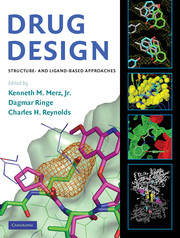Book contents
- Frontmatter
- Contents
- Contributors
- Preface
- DRUG DESIGN
- 1 Progress and issues for computationally guided lead discovery and optimization
- PART I STRUCTURAL BIOLOGY
- PART II COMPUTATIONAL CHEMISTRY METHODOLOGY
- 5 Free-energy calculations in structure-based drug design
- 6 Studies of drug resistance and the dynamic behavior of HIV-1 protease through molecular dynamics simulations
- 7 Docking: a domesday report
- 8 The role of quantum mechanics in structure-based drug design
- 9 Pharmacophore methods
- 10 QSAR in drug discovery
- 11 Predicting ADME properties in drug discovery
- PART III APPLICATIONS TO DRUG DISCOVERY
- Index
- References
8 - The role of quantum mechanics in structure-based drug design
from PART II - COMPUTATIONAL CHEMISTRY METHODOLOGY
Published online by Cambridge University Press: 06 July 2010
- Frontmatter
- Contents
- Contributors
- Preface
- DRUG DESIGN
- 1 Progress and issues for computationally guided lead discovery and optimization
- PART I STRUCTURAL BIOLOGY
- PART II COMPUTATIONAL CHEMISTRY METHODOLOGY
- 5 Free-energy calculations in structure-based drug design
- 6 Studies of drug resistance and the dynamic behavior of HIV-1 protease through molecular dynamics simulations
- 7 Docking: a domesday report
- 8 The role of quantum mechanics in structure-based drug design
- 9 Pharmacophore methods
- 10 QSAR in drug discovery
- 11 Predicting ADME properties in drug discovery
- PART III APPLICATIONS TO DRUG DISCOVERY
- Index
- References
Summary
INTRODUCTION
The routine use of quantum mechanics (QM) in all phases of in silico drug design is the logical next step in the evolution of this field. The first principles nature of QM allows it to systematically improve the accuracy of the description of the nature of the interactions between molecules. Moreover, the systematic way in which one can approach the use of QM methods to solve chemical and biological problems is quite appealing, but the practical use of many of the appealing features of QM in in silico drug design applications is still to be realized in large part because of computational limitations. In recent years it has become clear that classical potential functions are being pushed to their limits and as many pitfalls of using them are coming to light, one is tempted to explore the use of QM procedures. This is a somewhat naïve view, however, because one of the main observations of a large body of computational work has shown that sampling of relevant conformational states can be as important as providing an accurate representation of an inter-or intramolecular interaction. Hence, even as QM becomes a routine tool used to calculate the energy of individual states of a biological system, one still faces the daunting task of sampling relevant conformational space, which, in our view, will for the near term be largely confined to classical models.
- Type
- Chapter
- Information
- Drug DesignStructure- and Ligand-Based Approaches, pp. 120 - 136Publisher: Cambridge University PressPrint publication year: 2010
References
- 1
- Cited by



